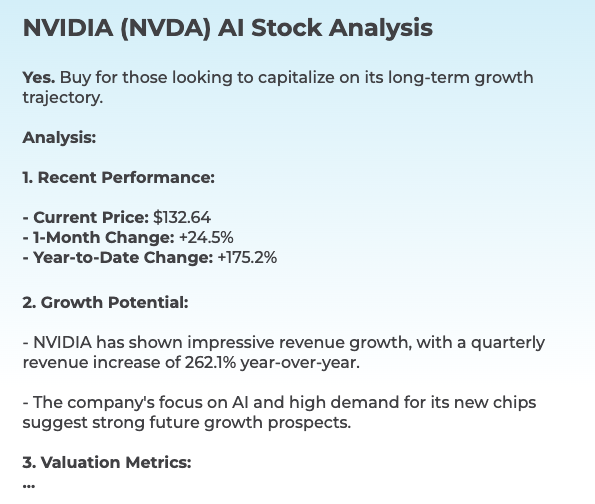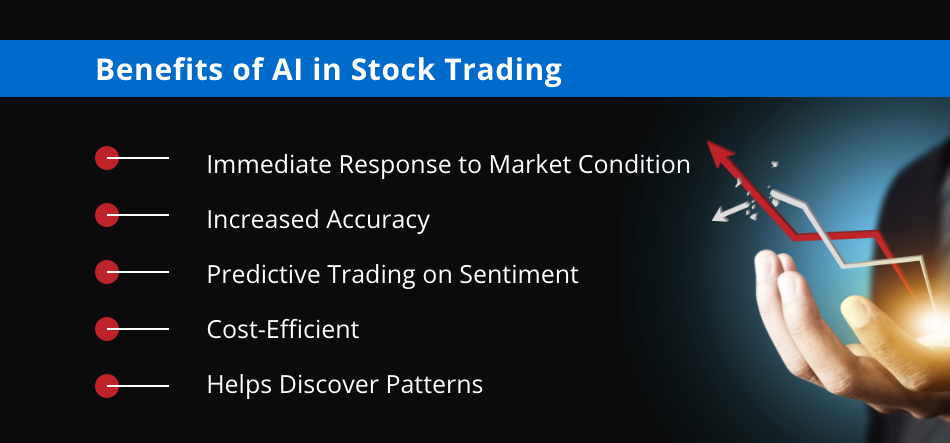20 New News To Selecting AI Stock Predictions Analysis Sites
20 New News To Selecting AI Stock Predictions Analysis Sites
Blog Article
Top 10 Tips To Assess The Integration And Compatibility Of Ai-Based Stock Forecasting And Trading Platforms
AI stock prediction and analysis platforms should be compatible and seamlessly integrate with the existing systems, tools, and workflows. A platform that integrates seamlessly into your existing workflows and tools will improve efficiency and efficiency. Here are the top ten tips to evaluate compatibility and integration.
1. Check Brokerage Integration
Integration of the platform with your preferred broker or trading accounts: Ensure that the platform works seamlessly with your chosen brokerage or account.
Execution of trades: Make sure that the platform supports the direct execution of trades via the broker integrated.
Account synchronization - Check to see if your platform can synchronize account balances, transactions, and positions in real-time.
2. Check the API's availability
API access - Ensure that the platform has an API that lets developers to create customized tools or automate workflow flows.
API documentation: Ensure the API is well documented by providing examples and usage-cases.
Rate limits: Determine if your API has reasonable rates limits that can handle the volume of usage you expect.
3. Integrating Third-Party Tools
Popular Tools: Make sure that the platform integrates with other software, like Google Sheets and Excel.
Export and import of data: Ensure that the platform permits easy export and import of data to and from other tools.
Extensions/Plugins: Verify whether the platform works with extensions or plugins for additional functionality.
4. Test Compatibility With Operating Systems
Desktop compatibility: Make sure the device is compatible with the OS of choice (Windows, macOS or Linux).
Mobile compatibility: Find out if the platform offers mobile apps for iOS as well as Android.
Web-based Access: Check if you can connect to the platform via a browser to increase flexibility.
5. Assessment of the Data Integration Capabilities
Data sources. Ensure the platform has several data integrations (e.g. data sources for market, social media sentiment news feeds, etc.).
Real-time analytics: Ensure that the platform integrates real-time analyses.
Historical data import: Check whether the platform supports the import of historical data to analyze or backtest.
6. Assess Cloud and On-Premise Compatibility
Cloud-based platform that is accessible any time, anywhere, as long as you have an Internet connection.
Solutions on-premise: If prefer to deploy on premises, check whether the platform is compatible with it.
Hybrid options: Check whether the platform has the option of a hybrid model, which combines cloud and on-premise capabilities.
7. Check for Cross Platform Syncronization
Device synchronization. Ensure data and settings are synchronized across all platforms (desktops mobiles, tablets).
Make sure that any changes made to one device are immediately reflected on the other devices.
Access offline: Determine whether the platform permits restricted functionality or data access when offline.
8. Analyzing the compatibility of trading strategies
Automated or algorithmic trading: Verify that the platform you use for trading supports these strategies.
Custom indicators: Check if your platform allows indicators or scripts that are unique to you.
Strategy backtesting: Check whether the platform can be used for backtesting trading strategies using historical data.
9. Examine Security and Compliance
Data encryption: Ensure the platform is using encryption for data during transit as well as in rest.
Authentication Check to see if your platform supports an authenticated method that is secure (e.g. 2-factor authentication).
Compliance with regulations - Make sure the your website is in compliance with the relevant laws, e.g. GDPR. FINRA. SEC.
10. Test Scalability, Performance, and Efficiency
Scalability is crucial. The platform should be able to handle the increasing volume of data and number of users.
Performance during load: Verify whether the platform performs as expected under high-volatility conditions.
Utilization of resources: Check the extent to which your platform is using the resources of its system (CPU/memory, bandwidth) effectively.
Bonus Tips
Customer feedback: Read user reviews and testimonials in order to assess the integration capabilities of the platform.
Trial period: Try the platform free of charge or download a demo to check out how it works with your current tools and workflows.
Customer support: Make sure that the platform offers a robust customer support for integration-related issues.
You can evaluate the compatibility, integration and efficacy of AI trading platforms for stocks using these suggestions. Follow the top best ai for trading examples for more examples including ai stock market, chart ai trading assistant, best ai trading software, ai stocks, options ai, trading with ai, chatgpt copyright, ai stock trading bot free, ai stock trading, best ai stock and more.
Top 10 Tips To Evaluate The Risk Management Of Ai Stock Predicting/Analyzing Trading Platforms
Any AI platform for analyzing or predicting stocks must include risk management that is crucial to protecting your capital and minimizing losses. A platform with robust tools for managing risk will help navigate the volatile market and enable users to make better choices. Here are the top ten suggestions for assessing risk management capability of these platforms.
1. Review Stop-Loss Features, Take-Profit Features
Levels that can be customized: Make sure your platform permits you to set stop-loss and take-profit levels for each trade or strategy.
Find out if the platform allows for trailing stops. They automatically adapt themselves when market moves in your favor.
Guaranteed stops: Check if the platform offers guarantees on stop-loss orders that ensure your position is closed at the specified price regardless of market volatility.
2. Instruments for assessing position Size
Fixed amount - Ensure you can define the size of your positions according to a certain amount.
Percentage of Portfolio: Decide whether it is possible to establish the size of your position as a percentage of your portfolio total so that you can manage risk in a proportional way.
Risk-reward ratio: Determine if the platform supports setting risk-reward ratios for specific strategies or trades.
3. Check for Diversification Aid
Multi-asset trading. Make sure that your platform is compatible with multiple asset classes such as ETFs, Forex, Options, and Stocks.
Sector allocation: Make sure the platform is equipped with tools to monitor the sector's exposure.
Geographic diversification: Make sure that the platform permits trading on international markets to spread the geographic risk.
4. Evaluation of Leverage and Margin controls
Margin requirements: Ensure that the platform is clear about limitations on margins when trading leveraged.
Find out the leverage limits. This feature to limit your exposure to risk.
Margin calls: Check if you are receiving prompt messages from the platform to ensure that your account is not liquidated.
5. Assessment and reporting of risk
Risk metrics: Make sure the platform offers key risk metrics to your portfolio (e.g. Value at Risk (VaR), sharpe ratio, and drawdown).
Scenario Analysis: Determine the platform you use allows the capability of generating different market scenarios to determine the potential risks.
Performance reports: Make sure you check if the platform provides detailed performance reports, including risk-adjusted returns.
6. Check for Real-Time Risk Monitoring
Portfolio monitoring: Make sure the platform you use allows you to track your portfolio in real-time.
Notifications and alerts: Determine if the platform provides real-time alerts regarding events that are risky (e.g., margin breaches and stop-loss triggers).
Risk dashboards - Check to see if the platform you are using has customizable risk dashboards. This will give you more information about the risks you're facing.
7. Test Stress Testing and backtesting
Stress testing: Ensure the platform you use allows you to test your strategies or portfolio under the most extreme market conditions.
Backtesting - Find out whether your platform permits you to backtest strategies with historical data. This is a fantastic method to gauge the risks and determine the performance.
Monte Carlo simulations: Verify that the platform is using Monte Carlo simulations to model a range of possible outcomes and assess risks.
8. Risk Management Regulations: Assess compliance
Compliance with Regulations: Check the platform's compliance with applicable Risk Management Regulations (e.g. MiFID II for Europe, Reg T for the U.S.).
Best execution: Check to see if your platform follows best execution procedures. This guarantees that trades are executed at the most efficient price, minimizing the chance of the chance of slippage.
Transparency: Verify that the platform has transparency and clear disclosures about the risks.
9. Check for Risk Parameters that are user-controlled
Custom risk rules: Ensure that the platform lets you define custom risk management rules (e.g., the maximum daily loss, or maximum size of position).
Automated risk control: Ensure that the platform enforces risk management rules automatically based upon your predefined criteria.
Check whether the platform permits manual overrides for automated risk controls.
Review user feedback and case research
User reviews: Review reviews from customers to evaluate the effectiveness of the platform in risk management.
Case studies: Look for testimonials or case studies which highlight the platform's capabilities in risk management.
Forums for communities Find out if there is a vibrant community of traders who share their tips and strategies for risk management.
Bonus Tips:
Trial period: Try the demo or trial version for free to test the platform's risk management features in real-world scenarios.
Customer Support: Make sure that the platform can provide a comprehensive customer support solution for any risk management related concerns or questions.
Educational resources: Find out whether you can find any educational materials available on best practices in managing risk.
The following tips can aid you in evaluating the risk management capabilities provided by AI platform for predicting or analyzing stocks. You can choose a platform to ensure your capital is protected while minimizing possible losses. To stay out of unstable markets and to achieve long-term gains in trading, you need robust software for managing risk. View the recommended enquiry for blog recommendations including best stock prediction website, stock predictor, chart analysis ai, ai stock predictions, how to use ai for stock trading, ai software stocks, best ai stocks to buy now, ai stock prediction, ai stock trader, free ai stock picker and more.